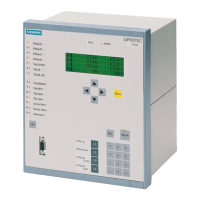'(& )( )'& &) ( &!& ")& &$(( $# Ć %&( $# #)" &&#$
Operating instructions
6
6 - 3
Siemens AG ⋅ May 1998
6.2 Setting the protection
6.2.1 Introduction
For setting the operational parameters, it is necessary
to enter the codeword (password) (see 6.1.3). The
codeword is required in order to change the settings
but not to read out the settings.
There are three types of display:
D Addresses without request for operator input
The address is identified by the block number folĆ
lowed by 00 (e.g. 4000 for block 40). Displayed
text forms the heading of this block. No input is
expected. By using keysB or Y the next or preĆ
vious block can be selected. By using keysA or "
the first or last address within the block can be
selected and the addresses stepped trough.
D Addresses which require numerical input
The display shows the four-digit address, i.e.
block and running number (e.g. 6104 for block
61, running number 4). The meaning of the paĆ
rameter is displayed behind the bar. The second
line shows the value of this parameter. When the
relay is delivered a value has been preset. In the
following sections these default values are
marked. If this value is to be retained no other inĆ
puts are necessary. The next (or previous) parameĆ
ter within the block or the next (or previous) block
can be accessed by paging. If the value needs to
be altered it can be overwritten using the numeriĆ
cal keys and if applicable the decimal point and/or
the change sign (+/-) key. The permissible setting
range is given next to the associated box. Values
outside this range are rejected. The setting steps
correspond to the last decimal place shown in the
setting box. Inputs with more decimal places than
permitted will be truncated down to the permissiĆ
ble number. The value must be confirmed with
the enter key "ENTER" !
The display then confirms the accepted value. The
final transfer of the new parameter, however, ocĆ
curs only after completion of the parameter setting
process (refer below).
D Addresses which require text input
The display shows the four-digit address, i.e.
block and running number (e.g. 5102 for block
51 running number 2).The meaning of the paramĆ
eter is displayed behind the bar. The second line
shows the text of this parameter. When the relay
is delivered, a text has been preset. In the followĆ
ing sections these texts are marked. If it is to be
retained no input is necessary. The next (or preĆ
vious) parameter within the block or the next (or
previous) block can be accessed by paging. If the
text is to be changed, then this is performed by
the "No"-key "F4". One of the alternative choices
which are tagged to the display boxes in the folĆ
lowing sections then appears. If the alternative
text is not desired, the "F4" key is pressed
again, etc. The alternative which is chosen is conĆ
firmed with the enter key "ENTER".
The following sections include the parameterizing of
all setting values with explanations. The arrowsYB
and A"next to the display boxes indicate the methĆ
od of moving from block to block or within a block. If
the meaning of a parameter is unclear it is usually
best to retain the preset value. Addresses not in use
are skipped (passed over).
If the parameter address is known then direct adĆ
dressing is possible. This is achieved by depressing
key "MENU", followed by the four-digit address and
subsequently pressing the enter key "ENTER". After
direct addressing, paging by means of keys YB and
A" is possible.
The parameterizing process can be ended at any time
by depressing one of the keys YBwhich changes the
parameter block. The displayed question "CHANGE
COMPLETED?" is then answered with the Yes-key
"F3"
In general, the question as to the completion of paraĆ
meterizing appears each time a new block is chosen.
If further parameters are to be changed the question
should be answered by pressing the No-key "F4" .

